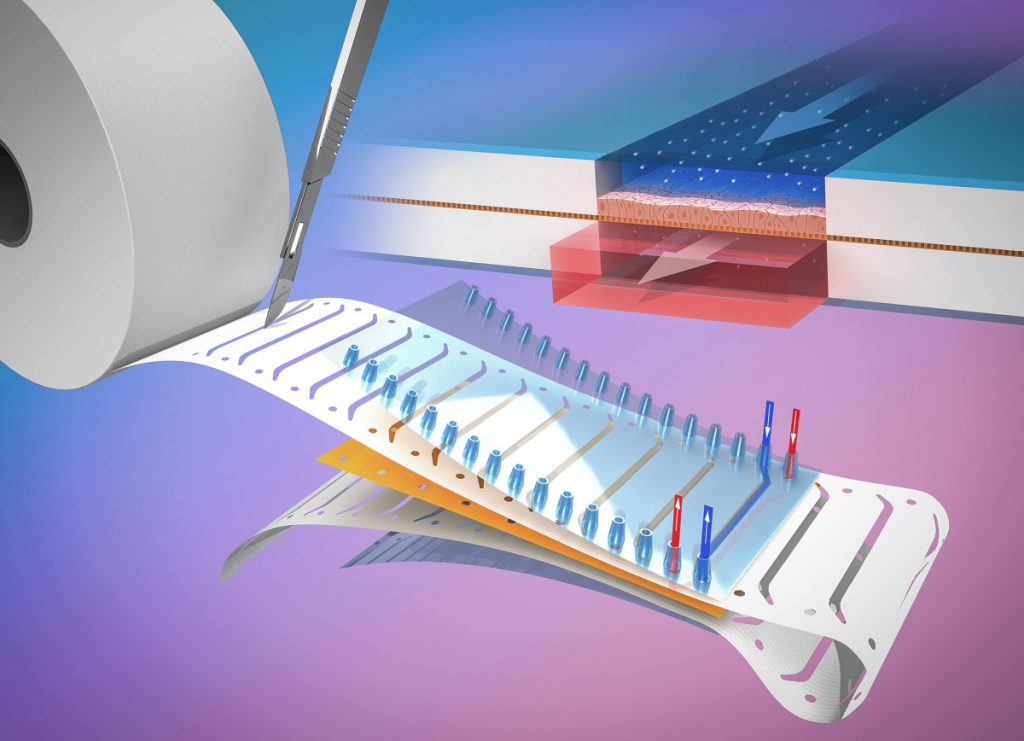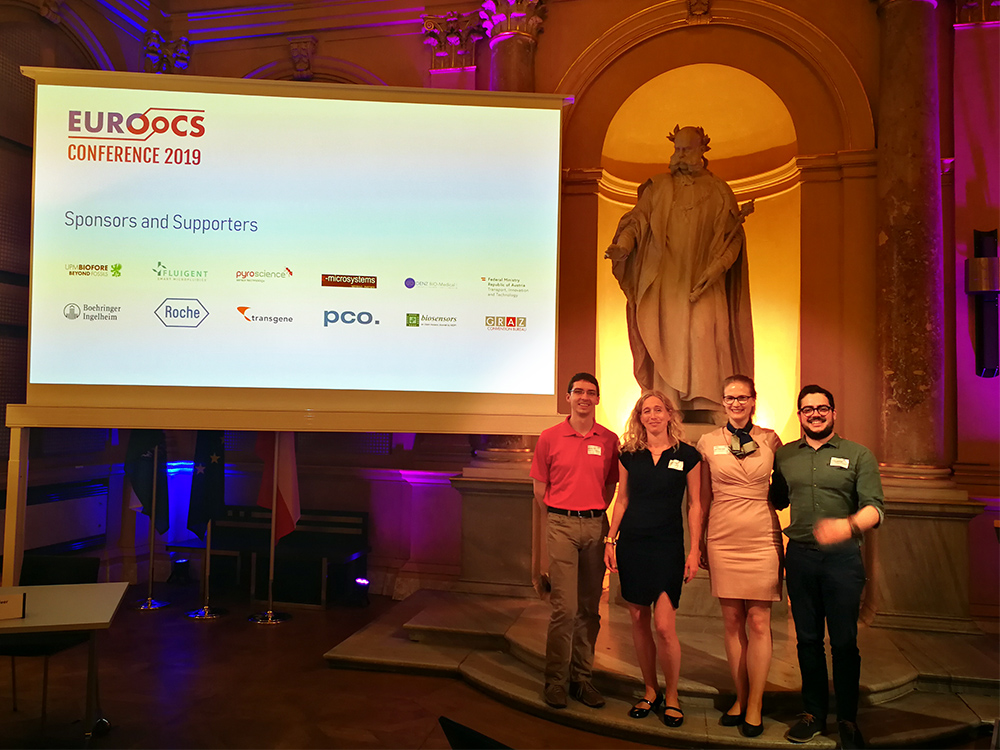The article “hiPS‐Derived Astroglia Model Show Temporal Transcriptomic Profile Related to Human Neural Development and Glia Competence Acquisition of a Maturing Astrocytic Identity” was published in the Advanced Biosystems today. The research highlights the directed differentiation of neuroepithelial stem cells undergoing a neurogenic-to-gliogenic competence. This NES-Astro model can be used for detailed mechanistic studies of RG and astrocyte development under normal conditions in addition to disease models.
Author: herlandlab
New paper published in Lab on a Chip
The article “Low-cost microphysiological systems: Feasibility study of a tape-based barrier-on-chip system for small intestine modeling” was published in Lab on a Chip today. The research highlights the use of simple double-sided tape to assemble an organ-on-a-chip system with human gut as a model, replacing the typically used expensive techniques and materials. This method will prove to be a robust and reproducible approach to studying physiological barriers, promising faster development of new drugs and precision and personalized medicine.
Link to the article in Lab on a Chip
Link to the back cover in Lab on a Chip

Erica accepted to the Lindau Nobel Laureate Meeting
Congratulations to our postdoc Erica Zeglio on being accepted to the prestigious 70th Lindau Nobel Laureate Meeting, taking place from 28 June to 3 July 2020, in Lindau, Germany!
New paper published in the Journal of Visualized Experiments (JoVE)
The article “Generation of a Human iPSC-Based Blood-Brain Barrier Chip” was published in the Journal of Visualized Experiments (JoVE) today. The research illustrates the possibility to combine organ-on-chip and induced pluripotent stem cell (iPSC) technologies to generate a BBB chip fully personalized to human barrier formation on a functional and transcriptional level.
Two new papers in Nature Biomedical Engineering
Two new articles on multi-organ in-vitro models developed in collaboration with the Wyss Institute were just published in Nature Biomedical Engineering as part of a collection on Microphysiological Systems: “Quantitative prediction of human pharmacokinetic responses to drugs via fluidically coupled vascularized organ chips” and “Robotic fluidic coupling and interrogation of multiple vascularized organ chips“. These platforms could drastically accelerate drug testing and provide accurate predictions of drug effects prior to clinical testing.
Xenia and Isabelle at Society for Neuroscience in Chicago
Thomas at the European Research and Innovation Days
Thomas pitched his (and the lab’s) research at the Marie Curie Falling Walls Lab in Brussels as part of the European Research and Innovation Days. He and the other 29 participants (selected from over 200 applicants) got the opportunity to present their research to a broad audience – in under 3 minutes each.
If you missed the live stream, you can watch his pitch here. The video is courtesy of the European Commission.
https://platform.twitter.com/widgets.jsThomas E Winkler breaking the wall of the brain’s blood vessels, literally. @Falling_Walls Lab #MSCA #RiDaysEU pic.twitter.com/kSoxjKRN2m
— MarieSkłodowskaCurie (@MSCActions) September 26, 2019
New Openings at all Levels
We currently have open positions available at all levels from Postdocs to Internships. Take a look here.
New PhD students join the group
Over the summer, Saumey Jain and Sebastian Buchmann have joined the Herland group as our newest PhD students. Saumey, who received his M.Sc. from KTH, is co-supervised by Prof. Frank Niklaus and will be working on nanopore sequencing. Sebastian, who graduated from the University of Basel, is co-supervised by Prof. Max Hamedi and will be working on organic electronic sensing and stimulation.
Herland lab at EurOoC in Graz

The KTH team spent two engaging & enjoyable days in Graz, Austria, at the European Organ-on-Chip conference.
Isabelle & Dimitris presented posters with their latest research results. Dimitris won one of four Travel Grants with his poster.
Thomas gave the Highlighted Presentation in the session on “Materials, analytics and in-line sensing”. His talk was awarded Best Paper at the closing ceremony.
Prof. Herland gives Keynote lecture
New Review published in Advanced Materials
Our expansive review paper “Conjugated Polymers for Assessing and Controlling Biological Functions” was published in Advanced Materials today. The article will be part of an issue dedicated to Professor Olle Inganäs (Linköping University) on the occasion of his Professor Emeritus title. Together with A.L. Rutz and G.G. Malliaras at the University of Cambridge, we discuss the use of conjugated polymer materials in five biologically oriented research topics: electrophysiology, tissue engineering, drug release, biosensing, and molecular bioelectronics.
Interview with Prof. Herland on new funding by VR
The Swedish Research Council (VR) awarded grants to 47 researchers at KTH, including 3.8 million SEK to Prof. Herland. She was interviewed for the occasion by the KTH press office (Swedish only).
New Paper published in Stem Cells
The article “Barrier properties and transcriptome expression in human iPSC‐derived models of the blood–brain barrier” was published in Stem Cells today. The research illustrates how co‐culture of iPS-derived endothelial cells with pericytes, astrocytes and neurons promotes barrier formation on a functional and transcriptional level.
New Paper published in Nature Biotechnology
The article “A linked organ-on-chip model of the human neurovascular unit reveals the metabolic coupling of endothelial and neuronal cells” was published in Nature Neuroscience today. The research illustrates how fluidically linked Blood-Brain Barrier and Brain Organ Chips offer new methods for studying the effects of drugs and disease on the brain and its blood vessels.
link to press release at the Wyss Institute
Xenia successfully defends her Doctoral thesis
Congratulations to our Postdoc Polyxeni Nikolakopoulou on successfully defending her Ph.D. thesis at the Technische Universität Dresden!
New intern joins the group
Today, Simon Feillée joins the Herland group as our newest internship student. He is pursuing a degree at Mines Paristech in France, and for her internship project will be working with Isabelle and Thomas on the controlling the surface chemistry of a novel polymer for microfluidic device fabrication.
Dimitri successfully defends his Master’s thesis
Congratulations to our Master’s thesis student Dimitri Wirjowerdojo on successfully defending his thesis “Evaluation of Hypoxia-induced Astrocytic Commitment of Neuroepithelial Stem Cells”.
Feature and Interview with Prof. Herland
The Wallenberg Foundation has published an article featuring Prof. Herland and her research (Swedish only).
Vlad successfully defends his Master’s thesis
Congratulations to our Master’s thesis student Vladimir Banovic on successfully defending his thesis “Real-Time Monitoring of Neurovascular Cells”.
New ERASMUS+ intern joins the group
Today, Eva Stronkman joins the Herland group as our newest ERASMUS+ internship student. She is pursuing a degree at Saxion University of Applied Sciences in the Netherlands, and for her internship project will be working with Thomas on the novel device fabrication methods for brain on a chip devices.
Thomas receives Marie Curie fellowship
Congratulations to our postdoc Thomas Winkler on being awarded a prestigious Marie Skłodowska-Curie Individual Fellowship by the European Commission for his work on “NeuroVU: Real-time Sensing in Microfluidic Models of the Neurovascular Unit”.
New Master’s student joins the group
Today, Dimitri Wirjowerdojo joins the Herland group as our newest Master’s student. He is getting his degree in Molecular Techniques in Life Science, and for his thesis work will be working with Dimitrios on the evaluation of hypoxia-induced astrocytic commitment of neuroepithelial stem cells.
New Postdoctoral Fellow joins the group
Today, Polyxenia Nikolakopoulou joins the Herland group as our newest Postdoctoral Fellow. She will be based at KI, working on human stem cell-derived microglia in models of neuro-inflammation.